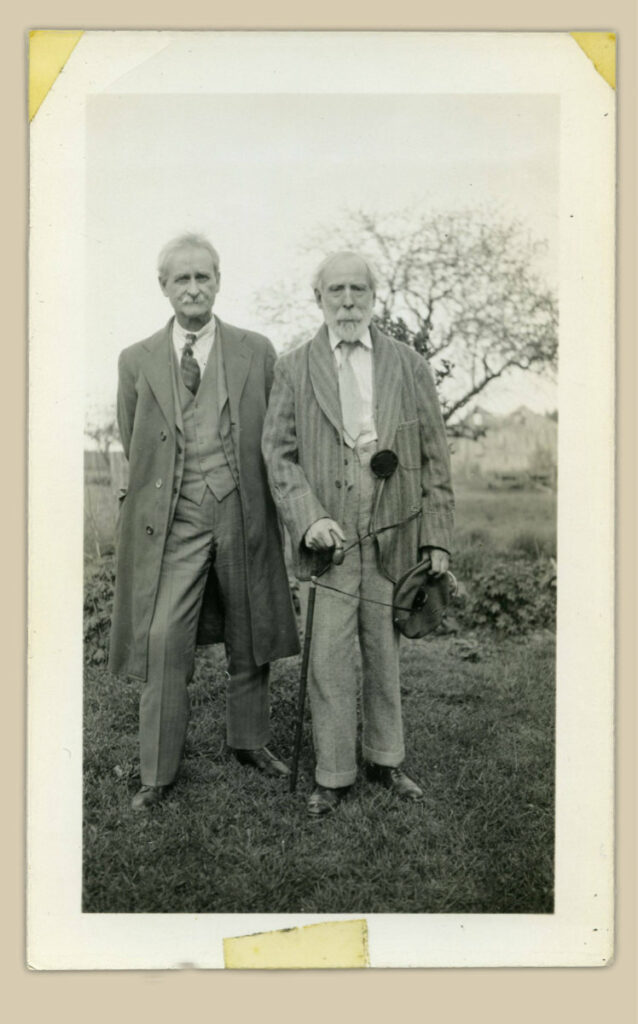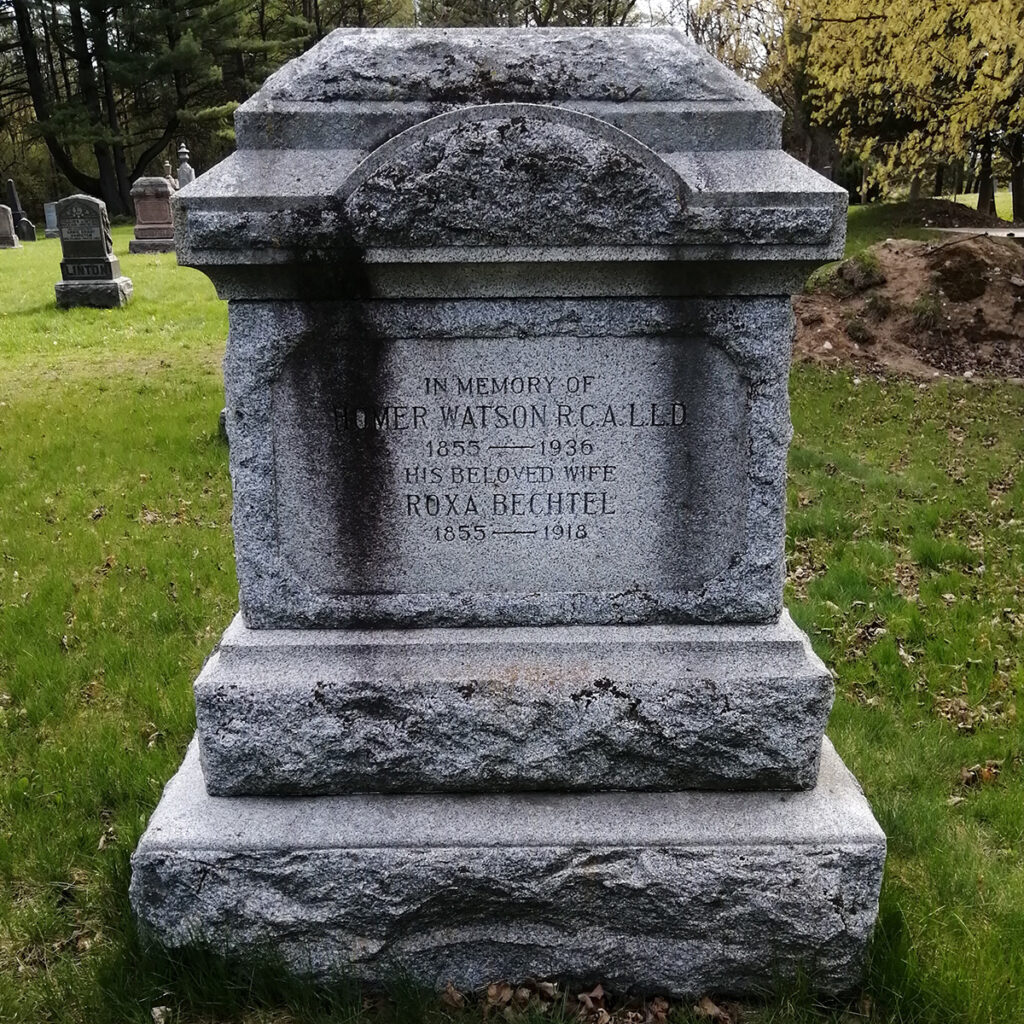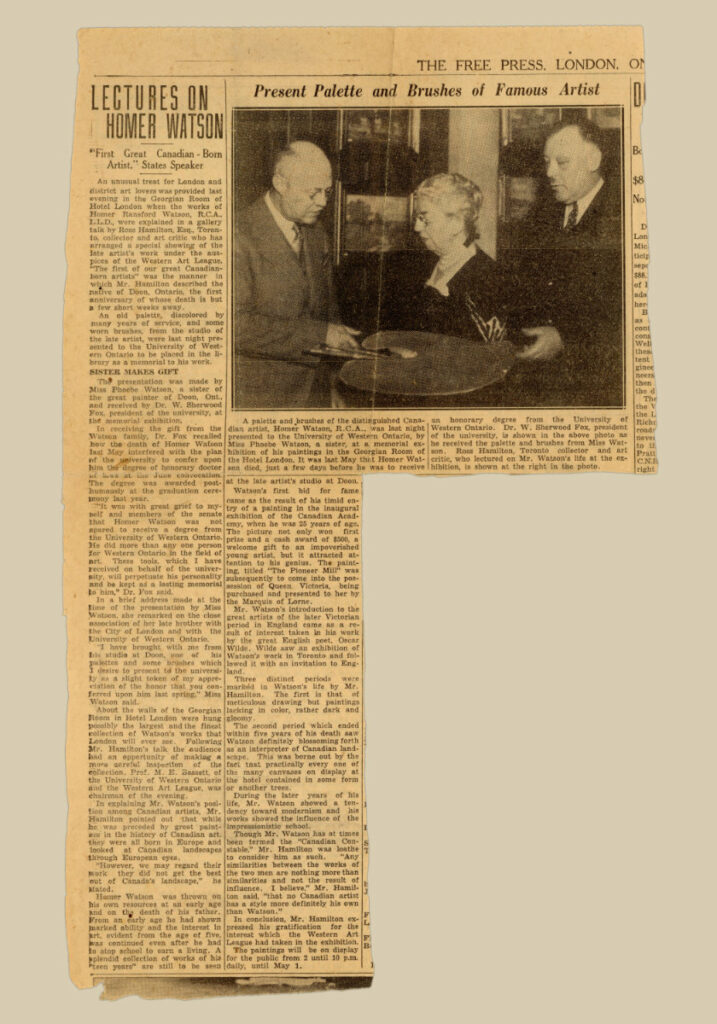Homer Watson: Late Career and Final Years
During his later life, Homer Watson faced many health issues that hindered – but did not completely stop – his ability and will to paint. He could make fewer sketching trips but was still able to continue his outings with the use of a car. His canvasses were smaller, and he focused on plein-air painting outside of his studio as the larger works put a strain on him.[1] However, his health was not the only major challenge he was facing.
The lingering effects of the Great Depression affecting the public’s general interest in buying art combined with changing tastes led to a decline in his popularity[2] – which all together put a significant financial burden on the Watsons. He eventually entered an agreement with the Waterloo Trust and Savings Company which exchanged the ownership of his artwork as collateral for a loan.[3] His sister Phoebe was apparently not as pleased with the agreement as he was, and she wrote to both Prime Minister Mackenzie King and the National Gallery of Canada requesting their support to help pay off the debt.[4]
Despite their difficulties, Homer carried on with his art as best he could. In 1930, an exhibition of his life’s work was displayed at the Grange Park Art Gallery, which would eventually become the Art Gallery of Ontario. What was likely the very last exhibition during his lifetime was held at the National Gallery of Canada in 1935.
Homer passed away on May 30th, 1936, in his Doon home. He is said to have left one unfinished painting on his easel, Sunshine Shower. Homer’s friend and biographer, Frank Page, remembered seeing him work on the piece:
His last picture “Sunshine Shower” stands on his easel in the studio just as he left it. I saw him working on this picture at various times as his failing strength allowed. He would say: “it is coming along, don’t you think so?” when he painted his last sketch, seated in a car, beside my summer cottage. He did this in forty minutes. “But it took it out of me,” he remarked. And lifting his hat to my little daughter as if she were a queen, he was driven away with a smiling face and a kindly invitation to visit him at Doon.[6]
Death Mask
Sculptor John Sloan Gordon was a friend of Homer’s and created a death mask of the deceased artist. A death mask is a plaster cast taken of a dead person’s face, which can then be used as a mould. The mask was used by Gordon to make a bronze bust.
Funeral
Homer Watson’s funeral was held on June 2nd, 1936. Cars crowded the street and non-relatives listened to the eulogy, delivered by Revered Water Patterson, over a loudspeaker outside of the house.[7] A tribute was read by fellow artist Sir Wyly Grier, who described Homer as someone who “lived for art”[8], and that “the great volume of his work is a portrayal of beauty and pleasantness for which the world is the richer.”[9] His casket was displayed underneath the painting The Valley of the Ridge in his gallery space. Frank Page recalls how he felt while attending:
And now, as he lay, so peaceful, surrounded by the work of his hands, anew the beauty of his refined hands, one of which had so often clasped mine in friendship. Alone with the mortal remails of Homer Watson, I placed my hand once more on his and felt his spirit lingered near.[10]
According to one of Homer’s nieces, when the casket was moved down the stairs there was a great “peal of thunder” despite it being a clear day[11] – a fitting tribute for an artist who loved to paint stormy skies. He was buried in Doon Presbyterian Cemetery alongside his beloved wife Roxa and other members of his family.
Honorary Degree
Shortly before his death, Homer was offered to attend convocation at the Western University and receive an honorary Doctor of Law degree. He unfortunately passed before being able to attend.
His sister Phoebe ended up going in his stead, and a few months later she gifted the university with one of Homer’s palettes and some of his brushes. These items have since been transferred to Homer Watson House & Gallery where they are currently displayed in the Watson Studio. At this presentation, Phoebe paid tribute to her brother using Rudyard Kipling’s poem When Earth’s Last Picture is Painted [12]:
When Earth’s last picture is painted and the tubes are twisted and dried,
When the oldest colours have faded, and the youngest critic has died,
We shall rest, and, faith, we shall need it — lie down for an aeon or two,
Till the Master of All Good Workmen shall put us to work anew.
[1] Muriel Miller, Homer Watson, The Man of Doon, 2nd ed., (Toronto: Summerhill Press, 1988), 109
[2] Brian Foss, Homer Watson: Life & Work (Toronto: The Art Canada Institute, 2018)
[3] Agreement between Homer Watson and the Waterloo Trust and Savings Co., February 7, 1933, Homer Watson House & Gallery Archives, Kitchener
[4] Gerald Noonan, Refining the Real Canada: Homer Watson’s Spiritual Landscape: A Biography (Waterloo: MLR Editions Canada, 1997), 196
[5] The Art Gallery of Toronto, Catalogue of an Exhibition of Paintings by Homer Watson R.C.A. O.S.A., (Toronto: Art Gallery of Toronto, 1930)
[6] Frank Page, Homer Watson, Artist and Man, (Kitchener: Commercial Printing Company, 1939), 45
[7] Jane Van Every, With Faith, Ignorance, and Delight, (Aylesbury: Homer Watson Trust), 1967, 44
[8] Quoted in Robinson MacLean, “Gilt Superlatives Wilted By ‘Dignity’ and ‘Worth’ In Life of Homer Watson”, Toronto Evening Telegram, June 4 1936
[9] Ibid.
[10] Page, Homer Watson, Artist and Man, 46-47
[11] Interview with a niece of the Watson family, conducted by Fran McIntosh and Mary Firth, November 30, 1987
[12] Miller, Homer Watson, The Man of Doon 2nd ed., 125









